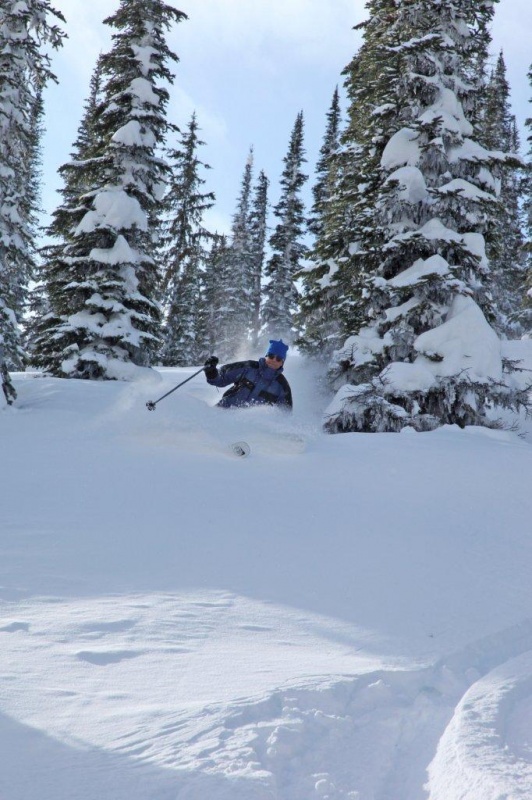Meadow Creek (BC), Canada – It’s been years since I signed up with Ski Plus Tours for my first ski vacation in the British Columbia interior, a guided road trip in 1997. Lead guide Brad Karafil operated on a flexible schedule, allowing him to follow weather patterns and utilize personal contacts to choose resorts or arrange occasional snowcat or heliski days for his guests.
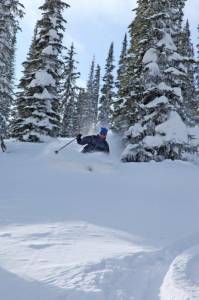
I have returned to the region nearly every season since, and the provincial government has allowed many new snowcat and heliski operations to open in the intervening years, during which Karafil and his wife Carole gave up Ski Plus Tours to open their own snowcat location in Meadow Creek, White Grizzly.
I skied with White Grizzly last March as my eighth Canadian snowcat operation to visit, joined by Sun Valley, Idaho photographer Karl Weatherly and author, retired climber and speed skier Dick Dorworth. Proudly proclaiming it his favorite place to ski anywhere, Karl had been there on four prior occasions and has repeatedly been lured to return by White Grizzly’s long, steep and consistent fall lines of over 2,500 vertical feet, more than 80 percent of which is in the trees. It comes as no surprise that White Grizzly’s bumper sticker slogan is, “Ski Good or Eat Wood.”
Location and Weather
White Grizzly’s lodge is located at the far north end of Kootenay Lake. It’s about a two-hour drive from Nelson, home to Whitewater Ski Area, and five hours in good weather from the airport in Spokane, Wash. Access from the north is less direct, three to four hours from Revelstoke including a once-per-hour ferry crossing.
The guides take snow measurements within the ski terrain every day they operate, generally about 80 percent of the time from New Year’s through mid-March and occasionally in shoulder seasons. While the snow records are not continuous, daily snowfalls tend to be about 10 percent more than that received at Whitewater and about 10 percent less than Mt. Fidelity in Glacier National Park, which works out to an annual average of 440 inches. The elevation range and weather are similar to other snowcat operations I have visited between Nelson and Revelstoke, including Baldface, Retallack and Great Northern. For all of these I recommend January into February for best snow preservation but White Grizzly’s consistent northeast exposure gives it an edge over those other destinations in March, although by the end of that month I would recommend looking elsewhere for a place with alpine terrain and higher elevation.
For one of the few times I can remember, upon my arrival there was perhaps too much snow. White Grizzly had received 50 inches in the 80 hours prior to my arrival and added another four on my first day. The rain/snow line was at 3,100 feet and the ski terrain ranges from 4,200 to 7,300 feet of elevation. Avalanche danger was extreme so we typically dropped in at around 6,500 feet. Pickups were on the higher road through a clearcut at around 5,100 feet as guides presumed that snow throughout the lowest 1,000 vertical feet would be heavier and hard to slog through until it had time to settle.
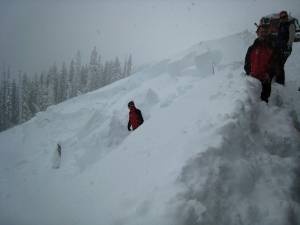
We kept to the steepest and tightest trees, both for safety and to keep moving through the deep snow. With that much snow, and at an estimated 10 percent density resistance was high and speed not an issue. The guides were justifiably very safety conscious, warning us about tree wells and showing us a slide that Brad had triggered right next to the cat road. Following our transceiver drill they dug a pit and analyzed a Rutschblock test before we started skiing.
With such long tree runs, White Grizzly always skis with two tail guides to better keep track of people, help with falls and lost gear, and to keep moving at a good pace. In one case I was near lead guide Shawn when he yelled to stop as he got a radio call from one of the tail guides. I stopped too abruptly, fell over headfirst on my back and the deep snow slid over my face. As I brushed it away more snow replaced it, so Shawn had to clear it away before I could get back on my feet.
At the bottom of every run the arms and front of my jacket would be caked in snow, which I would brush off as much as I could before getting in the cat. Nevertheless, by the end of the day most everyone’s clothing was wet or clammy from snow melting while in the cat. With transceiver drills, short runs and frequent regrouping under the intense conditions we only skied 7,800 vertical feet that first day, but we were quite sure how amazing the rest of the trip was going to be.
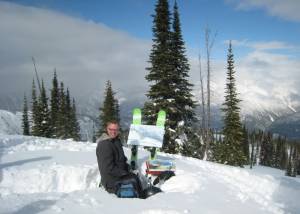
The storm let up overnight and by morning we were even treated to a few sunny breaks, prompting artist Jean-François Racine to join us in the cat. Racine, a Quebecker, paints mountain and ski scenes for White Grizzly, and he set up at our first drop point to paint for about five hours straight. His paintings are on display in the White Grizzly Lodge and are sold for between $550 and $1,800. This coming winter Racine will be living near Silver Star ski area in Vernon, British Columbia, and will be available by commission to White Grizzly customers.
Conditions on our second day were epic, as expected, rivaled by only one of my previous 15 Canadian snowcat trips. The snow this time was more dense, so while not flying over our heads it was as forgiving as can be for aggressive fall line skiing in the trees. This was the most comfortable I’ve ever been skiing in the woods.
Most of the group were Canadians in their late 30’s with a gung-ho attitude. One of them lost a brand new Rossignol S7, and a tail guide helped with the search while the rest of the group went for another lap, coming in from above to lend further assistance until it was located about five minutes after our return.
Our fifth run, Lover’s leap, was followed by a full-length Bishop’s Prayer to finish up the day after tallying 13,800 vertical feet. Brad says that due to hours of sunlight, a typical ski day ranges from five runs at New Year’s to six runs by mid-February. Under good conditions March can allow seven to eight runs in a day, but Brad described our group as “above average in ability but below average in organization.” With regroups, photo ops, etc. we were doing six runs, which at 15,000 vertical feet or more is a full day on White Grizzly’s terrain and considerably more demanding than the 10,000-12,000 of shorter runs at many other operations. Eight runs would be 22,000 vertical feet, and you would need a very strong and disciplined group to sustain that kind of pace.
Weather on day three was marked by a high overcast, so the snow settled only marginally overnight. We still had to be aware of tree wells, where one of the Canadians fell in up to his chest.
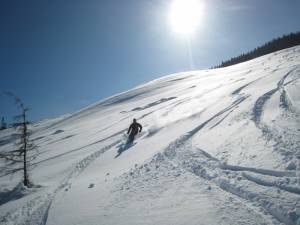
Ski conditions nonetheless remained outstanding, and thanks to the settling snow we were allowed into a few open spaces. White Grizzly’s terrain is generally forested except for a clearcut, but there are some huge boulder fields, notably North Bowl and Bu Bu Bowl, that get buried under three meters or more of snow to reveal pillow lines or bigger drops for guests who want some air time as did several of the Canadians. We skied six runs that day spanning 15,500 vertical feet.
By our fourth day weather turned warmer, with sun shining throughout most of the morning and panoramic views spreading across the valley from the Purcells to the Bugaboos. The 30,000 or more acres of terrain at the big, sprawling cat operations like Chatter Creek, Mustang Powder and Baldface Lodge have exposures all over the compass rose. White Grizzly has 11,000 acres of tenure but is presently using only 6,500 to maintain more personalized service by utilizing only one snowcat. With one cat it takes three weeks to track out those 6,500 acres, even if there is no new snow, and all of it is on one broad forested face with predominant northeast exposure to preserve conditions even in warm, sunny weather.
We took an early run in the Secret Gully/McSteamy’s area that faces more directly east than most of White Grizzly’s terrain. Where exposed to the sun the snow’s consistency became more like smooth cream cheese, which was fine while we were skiing it but less likely to remain so after an overnight refreeze. Most of our skiing this fourth day took place more northerly facing terrain that yielded conditions that were similar to those we enjoyed the two previous days. If the snow gets too heavy at lower elevation White Grizzly’s guides will use the higher pickup location, but you’re still getting close to 2,000 vertical feet per run even by doing that. On this day we were still skiing down to the low pickup on all six of our runs for 15,400 total vertical feet. Snow was still outstanding in the clearcut near the bottom and just starting to get heavier for the final 500 vertical feet.
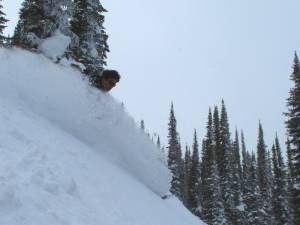
I used White Grizzly’s rental skis, which were White Dot Preachers. Interestingly, Brad is not a big fan of rockered skis. He thinks short and wide is the way to go in the trees. The Preachers were 155cm at the tip and 115 underfoot but only 169cm long. They worked out well for me at any rate, but I’d suspect that most powder skis would have been fine in these conditions.
Unique Features
Brad and Carole Karafil’s philosophy is somewhat distinctive in the cat skiing world. They want to provide a hands-on premium level ski experience for a bit less cost than that charged by many other places. The going rate for a tour at Mustang, Chatter Creek, Baldface, Island Lake is about $900 per day, although you can sometimes get in at one of those places for a discount at the last minute.
The Karafils have the opposite view, choosing instead to reward their repeat customers as the price per day decreases as the number of days booked and the amount of time in advance you book increases. A single-day late booking price is $800 per day. An advance trip booked a year ahead for four days costs $600 per day. Prices are kept lower as White Grizzly’s lodge location in Meadow Creek is accessible and hooked up to B.C.’s power grid, absolving the need for generator power and supplies delivered by snowcat. The Karafils also rent the lodge to work crews during the summer, helping to subsidize the cost of their ski operations.
The downside to White Grizzly’s lodge location is that you need to leave the lodge by 8 a.m. to drive to a staging area before riding the snowcat for a 5,000-foot climb. That means that you don’t start skiing until around 9:45 a.m., and you don’t return to the lodge until sunset. This would normally mean less time for skiing, but White Grizzly’s strong groups and long runs mean that you still get in more skiing than can be had at most other locations.
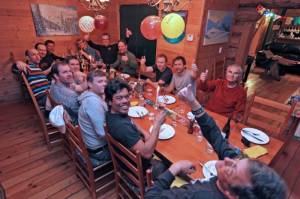
Tours at White Grizzly do not have a set date. Instead, the first customer to ask for a trip can choose the start date and the length of the trip. A tour needs eight clients to run and the maximum for the cat is 12. Brad is the lead guide every day and Carole often skis the morning before returning to the lodge to oversee dinner preparation.
White Grizzly is admittedly not the place for first timers unless they have extensive experience and comfort in skiing challenging tree runs. Trees in the northeastern U.S. are as tight as they are anywhere, so even though they are not as steep, White Grizzly is a natural fit for accomplished New England woodchucks. It’s therefore not surprising that Brad mentioned that several Mad River Glen shareholders are among his recurring clients.
Brad or Carole conduct extensive phone interviews with first timers, warning them they will be sitting out runs if they can’t keep up and suggesting that they first try somewhere else if they are not sure. This screening process has been successful in avoiding large divergences in ability, a problem that I have seen occasionally at other destinations that run only one snowcat.
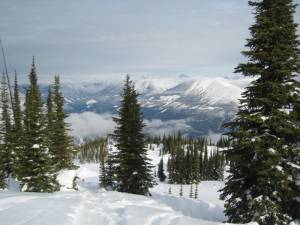
White Grizzly’s lodge facility, food and other amenities are similar in quality to what I’ve experienced at Mustang, Chatter Creek and Baldface, but are more intimate as White Grizzly hosts only one group at a time. A porch shelters a welcoming hot tub in back of the lodge. If you’re sensitive to price, the extra two hours spent per day in transit to the skiing is a small price to pay for a ski experience equal to — and perhaps better for tree skiing aficionados — than that provided by the more famous and expensive snowcat skiing resorts in Canada.

